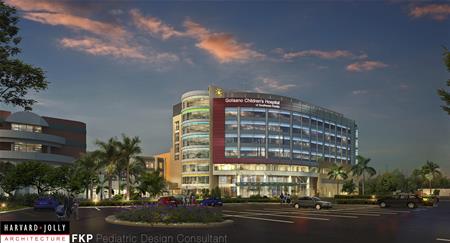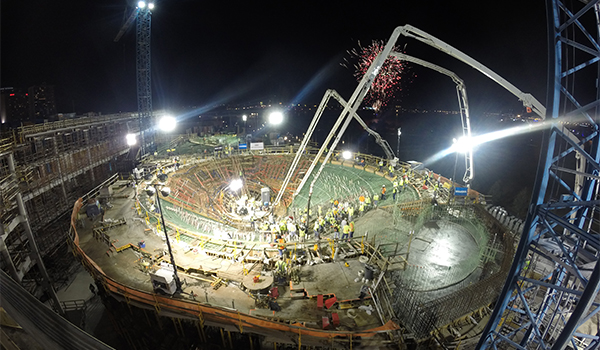
The stakes were very high for this aspect of Skanska's new $101-million Patricia and Phillip Frost Museum of Science project: The tank can"t have any cracks large enough to let water pass through, which essentially means no cracks at all, and certainly not any construction joints. When the science museum opens as expected in summer 2016, visitors will be able to walk below the suspended, conical tank and view sharks and other aquatic life through a 30-foot-diameter, up to 18-inch-thick acrylic lens at the center of the base.
 To enable a successful pour, the project team — including program manager Hill International and trade contractor Baker Concrete — took every precaution to guard against potential issues.
To enable a successful pour, the project team — including program manager Hill International and trade contractor Baker Concrete — took every precaution to guard against potential issues.
- Multiple mock-up pours were done to ensure the proper concrete mix. The concrete needed to work with the tank's challenging geometry, including angles of up to nearly 44 degrees that could cause concrete to slide. The mix also had to fit between dense layers of hefty rebar and post-tensioning cables to create sections up to nearly five feet thick.
- Mechanics were onsite should one of the three concrete pumps break down, and also at the concrete plant. Both a concrete pump and a conveyor belt at the plant went down for 30 minutes during the overnight pour, but the team didn"t break a sweat. “Those were hiccups that we had anticipated and that we had back-up plans for,” said Scott Davis, senior superintendent. Even more, if one of the pumps had failed beyond repair, a wrecker truck was onsite to tow it out of position so a replacement could be brought in.
- Fire department rescue teams came to the project on three days the week ahead of the pour to do drills with the project team, in case there would be a catastrophic form or shoring failure that trapped workers. Six concrete columns and a myriad of shoring supported the suspended tank during the pour.
But whether this pour — requiring 150 people for each of two shifts and 131 concrete trucks — should go ahead came down to an afternoon meeting the day before the scheduled event: Was everything — including the weather — ready for the pour to proceed? The team decided it was.
 At 4:35 p.m. on Friday, Dec. 12, the team proceeded with its approach. Beginning the pour at the base and proceeding both clockwise and counterclockwise, they worked as the arms of the concrete pumps reached out like praying mantises above them. The collaborative quality assurance/quality control process that had been integral to all aspects of preparing for the pour continued, with the team checking every truckload of concrete that arrived on site, even tracking graphically where in the tank each load was placed should any issues be identified during ongoing testing.
At 4:35 p.m. on Friday, Dec. 12, the team proceeded with its approach. Beginning the pour at the base and proceeding both clockwise and counterclockwise, they worked as the arms of the concrete pumps reached out like praying mantises above them. The collaborative quality assurance/quality control process that had been integral to all aspects of preparing for the pour continued, with the team checking every truckload of concrete that arrived on site, even tracking graphically where in the tank each load was placed should any issues be identified during ongoing testing.
“This is a remarkable team that volunteered when called upon and not only helped but succeeded in performing an extremely difficult coordination between the pump trucks, the work in the tank and documenting each and every truck load placement,” said Frank Longo, project director.
View the time-lapse video of the pour as it unfolded at Aquarium Pour Time Lapse from Multivision Video & Film on Vimeo.
At 5:25 p.m. on Saturday, the pour was done.
“All in all, it was a great day and night, with no safety issues,” said Nicole Heran, senior project manager.
The team is already onto its next unusual and significant challenge: erecting a spherical planetarium made out of precast concrete segments shaped like orange peels. These significant lifts require a 550-ton crane.
Besides the aquarium and planetarium, the 250,000-square-foot museum will include exhibition halls and indoor and outdoor science exhibits. The museum — in downtown Miami's Museum Park — is targeting LEED Platinum certification.


 Join our thriving community of 70,000+ superintendents and trade professionals on LinkedIn!
Join our thriving community of 70,000+ superintendents and trade professionals on LinkedIn! Search our job board for your next opportunity, or post an opening within your company.
Search our job board for your next opportunity, or post an opening within your company. Subscribe to our monthly
Construction Superintendent eNewsletter and stay current.
Subscribe to our monthly
Construction Superintendent eNewsletter and stay current.